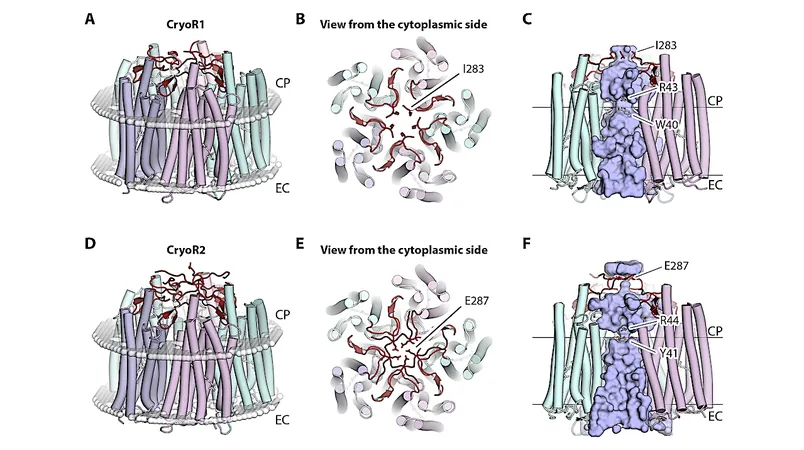
Unlocking the Secrets of Opioid Management: How Pharmacists are Changing the Game for OUD and C-POD Care
2025-05-21
Author: Benjamin
A Crisis on a Rampage: Understanding the Opioid Epidemic
In 2022, the opioid epidemic reached a staggering milestone in the U.S., with over 100,000 opioid-related deaths—marking the highest annual toll since 1999. While the numbers have seen a decline, opioid use disorder (OUD) continues to wreak havoc on public health, affecting countless lives and overwhelming healthcare systems.
Insight from Experts: Tackling Pain Management Challenges
At the upcoming 2025 Virtual Conference on Pain and Palliative Care, pharmacists Isabelle Zerfas and Abbey Galligan from the University of Michigan Health are set to shed light on the complex landscape of pain management amidst OUD. They are set to discuss how various degrees of opioid dependence demand tailored treatment strategies.
What is OUD? A Closer Look
OUD is marked by the compulsive use of opioids that severely impacts a person's life. Alarmingly, 45-64% of patients with OUD also suffer from chronic pain, making effective pain management crucial.
Turning the Tide: Medication-Assisted Treatment (MAT)
The gold standard in combating OUD is through medications for opioid use disorder (MOUD) like buprenorphine and methadone. Recent efforts to increase access have resulted in a notable 24% decrease in opioid-related deaths—an exciting milestone after a long struggle against this epidemic.
Federal Moves: Opening Doors for Treatment
Recent federal actions, such as the elimination of the X-waiver for prescribing buprenorphine and the Mental Health Parity and Addiction Equity Act, have broadened access to treatments for OUD, especially in traditionally underserved communities.
The Shadow of Stigma: OUD Management Hurdles
Despite progress, managing chronic pain in OUD patients remains fraught with challenges. From societal stigma to regulatory barriers and disparities in treatment access, many patients struggle to obtain adequate care.
The Confusion of C-POD: A Complex Condition
Patients grappling with complex persistent opioid dependence (C-POD) often face misdiagnosis as their symptoms blend the lines between physical dependence and addiction, making effective treatment even more difficult.
Effective Strategies: Making OUD Treatment Work
Medication-assisted treatment (MAT) remains essential for those battling OUD. Tailoring buprenorphine doses—especially in an era dominated by fentanyl use—can significantly improve patient outcomes.
Innovative Approaches to C-POD Management
Managing C-POD requires finesse; abrupt opioid tapering can do more harm than good. Instead, maintaining current opioid regimens while incorporating behavioral therapies is essential for improving quality of life.
The Power of Non-Pharmacologic Strategies
Innovative approaches also include non-opioid analgesics and complementary therapies, which can provide holistic relief for both OUD and C-POD patients.
Why Pharmacists are Key Players in Treatment
Pharmacists play a pivotal role in managing patients with OUD and C-POD. Their accessibility makes them vital in screening for misuse, counseling on MOUD use, and advocating for stigma-free treatment.
Bridging Gaps: The Pharmacist's Role in Care
From monitoring medication adherence to educating patients on tailored treatment strategies, pharmacists are crucial in ensuring effective OUD and C-POD management.
Conclusion: A United Front Against OUD and C-POD
Addressing OUD and C-POD demands a comprehensive, individualized approach. Pharmacists, armed with clinical expertise and advocacy skills, are essential partners in navigating this crisis and promoting equitable care.









 Brasil (PT)
Brasil (PT)
 Canada (EN)
Canada (EN)
 Chile (ES)
Chile (ES)
 Česko (CS)
Česko (CS)
 대한민국 (KO)
대한민국 (KO)
 España (ES)
España (ES)
 France (FR)
France (FR)
 Hong Kong (EN)
Hong Kong (EN)
 Italia (IT)
Italia (IT)
 日本 (JA)
日本 (JA)
 Magyarország (HU)
Magyarország (HU)
 Norge (NO)
Norge (NO)
 Polska (PL)
Polska (PL)
 Schweiz (DE)
Schweiz (DE)
 Singapore (EN)
Singapore (EN)
 Sverige (SV)
Sverige (SV)
 Suomi (FI)
Suomi (FI)
 Türkiye (TR)
Türkiye (TR)
 الإمارات العربية المتحدة (AR)
الإمارات العربية المتحدة (AR)